Last year we took a look at Kindle Unlimited and what it means for authors and publishers. The program is still going strong, and Amazon is continuing to market Kindle Unlimited heavily around the Kindle store. We decided to take another look at the current state of kindle unlimited royalties and conjecture on what is to come.
What is KU?: A Recap
For Readers:
Kindle Unlimited (or KU) is a subscription service that Amazon launched in July of 2014 (think Netflix for books). Readers who subscribe to KU can read an unlimited number of titles from the KU library, for just $9.99 month. A KU subscription also includes access to many popular magazines, as well as access to the audiobook versions of many titles in the library.
For Authors:
In order to be included in the KU Library, authors must exclusively publish their title on Amazon through KDP Select. That means the title cannot be available for purchase on any other retailer (Barnes & Noble, Apple, Kobo etc). Authors whose titles are part of the Kindle Unlimited library are not paid by “purchase” or by “download”, instead they are paid by the total number of pages read in any given month. The payout for pages read has been around just under 1/2 a cent per page ($0.00488 per page to be exact) for over a year now. At the end of every month, Amazon sets aside a pot of money (recently around 17 million dollars), called the KDP Global Fund, to be paid out to authors whose titles are enrolled in KU. Each author receives a portion of the pot proportional to how many pages of their titles were read. The more pages read the bigger the payout.
Let’s take a look at the growth of the KDP Global Fund over the years, and see where it may go next.
Growth of the Kindle Unlimited Royalties and the KDP Global Fund Since Inception
The first Kindle Unlimited fund was $2.5 million back in 2014. In January of 2017 it was $17.6 million. As no traditional publishers offer their titles in Kindle Unlimited, that $17 million pot is being paid out mostly to indie authors and small presses.
The fund has been on an upward trajectory since its inception with the biggest payout month ever being in January 2017 at $17.8 million. The fund has gone up more sharply in January for the past to years, followed by a dip in February. Why would that be? Well, some months have 30 days, other have 31 days, and February has 28 days. More days in a month means more days when readers are reading and therefore more pages can be read. We didn’t want the length of the month muddying up our data, so we graphed the average payout per day below to control for the length of each month.
Average KDP Global Fund By Day
This chart helps to control for the different number of days in each month. Once you control for February being the shortest month, we can see that there actually was not a “drop” in February. This tells us that Amazon makes the fund smaller in February because there are fewer days, not because they want to pay authors less money. What you can see here is that the size of the KDP global fund is growing pretty consistently and in February, Amazon was paying out about $600,000 per day to authors in KU, the most yet.
KDP Global Fund Projections
How big will the KDP Global Fund be in 3 months? 6 months? at the end of the year? Nobody knows for sure (except Amazon), but we can make some educated guesses based on the historical data.
The average increase each month from February to December in 2016 was 1.1%, so we assumed that level of increase for the rest of the year to see how it would look. In this scenario, the fund is about $628,000 per day (just shy of $20 million / month) by the end of the year.
Next, let’s get a little crazy (we are here to dream about possibilities, right?). The KDP Global Fund increased 3% from November to December 2016. What if they were to keep this trend, and continue to grow the Fund size by 3% every month? That would look like this, and the Fund would be a whopping 23.2 million dollars by the end of the year:
This scenario is fairly unlikely unless a lot more readers start using KU, but it’s fun to think about 🙂
Back to what we know:
KENP Payout Per Page
This is the rate that authors are being paid for each page that a KU reader consumes. As mentioned above, the average payout is $0.00488 and hasn’t changed much since Amazon started paying by page read. The dip down to $0.0041 that we see in January of 2016 was due to a change in the way Amazon measured a Kindle page, but as you can see, they straightened that out fairly quickly and page values returned back to their previous amounts.
The fact that the per page payout has stayed fairly static over time, while the KDP Global Fund has grown, tells us that there are more readers using KU every month. If Amazon wasn’t seeing more pages read in KU, then they wouldn’t keep making the Fund bigger in order to keep the per page rate the same.
Based on February’s KENP Payout of $0.005, an author would earn $1.50 for a 300 page book, $1.25 for a 250 page book and $1.00 for a 200 page book (assuming the reader completes the book). Whether to enroll a title in Kindle Unlimited is a choice every author has to make for themselves, as there are pros and cons to the program.
These graphs paint the picture of a service that is actively growing in users, and proving to be lucrative for some authors. What’s next? We can only guess. We’ll keep you posted on our blog as new developments arise.
Are your titles in KU? What has your experience been with the program?

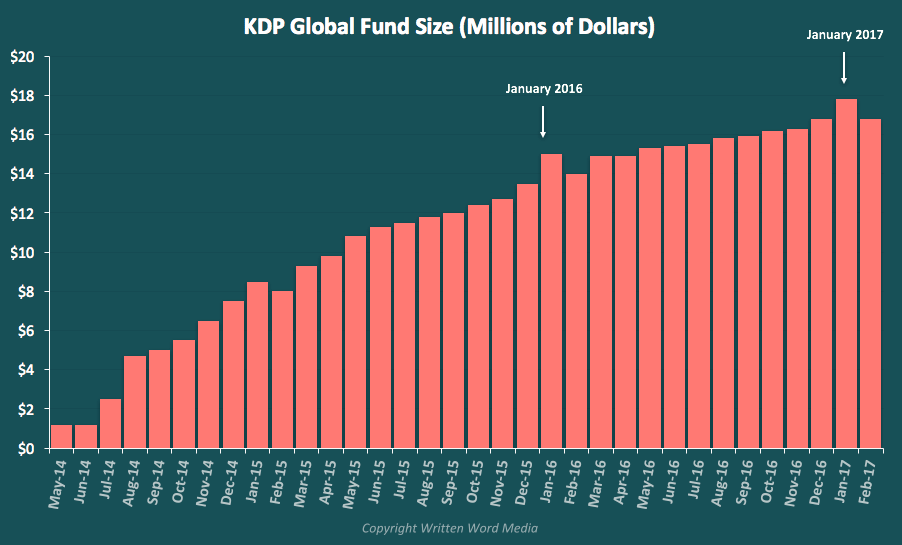
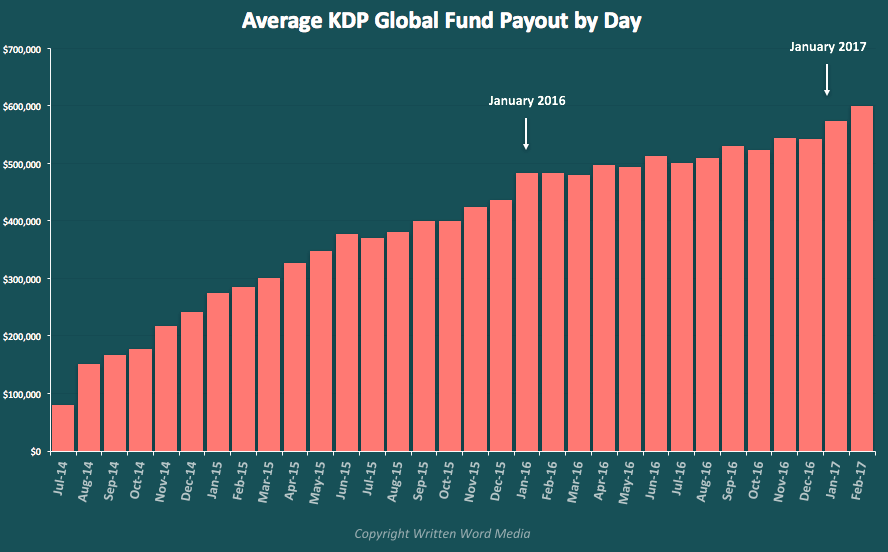
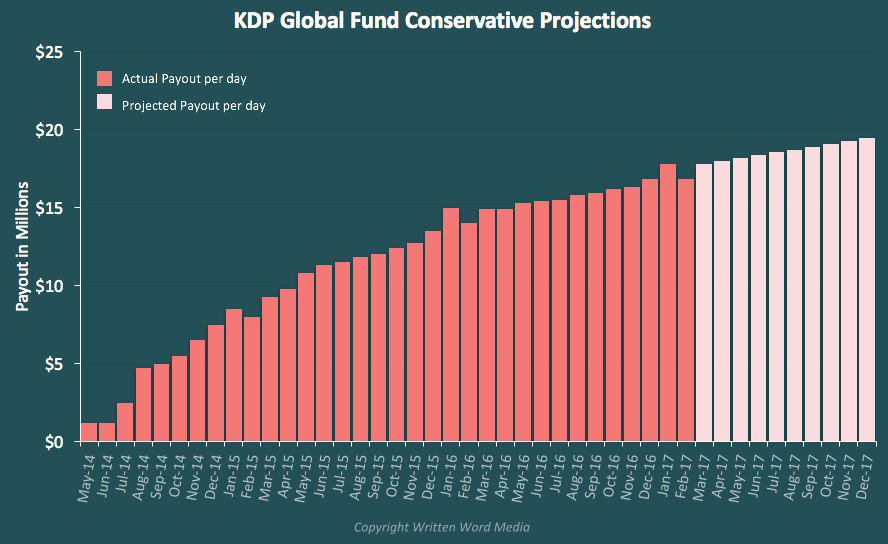
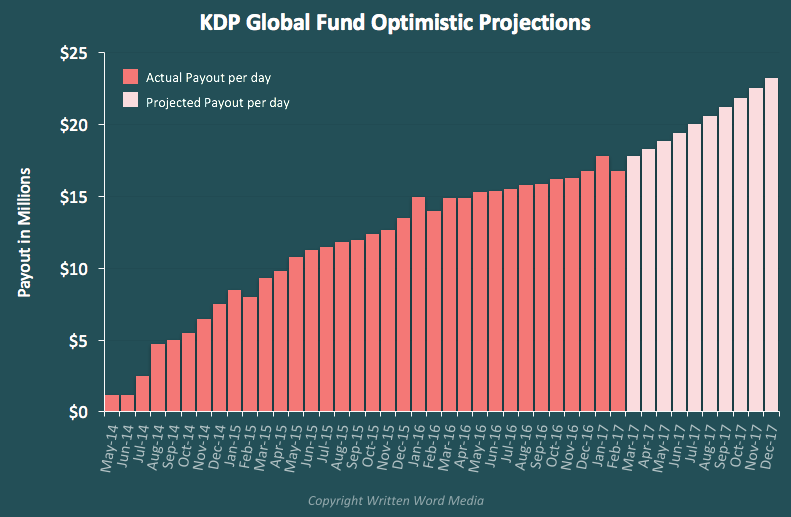
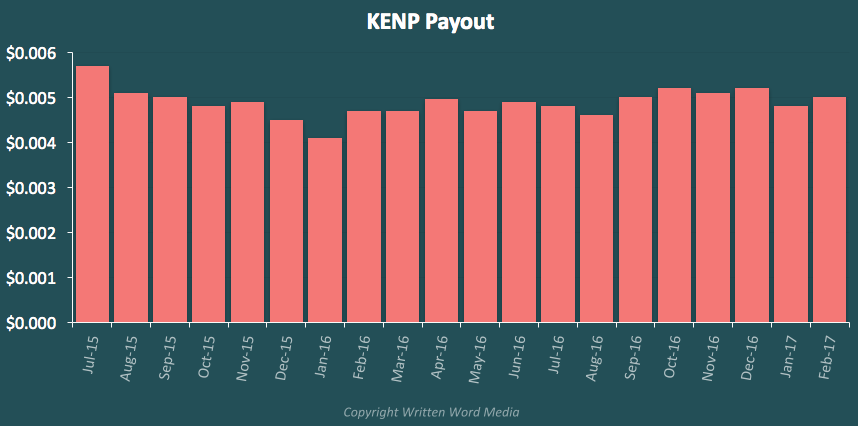
Very interesting. You could do a comparison of KU payout rates between countries. I understand that the KENP rate varies from country to country, with subscribers in poorer countries paying less, which affects the KENP rate.
Unless you already have a significant base of readers, the Kindle Select program is of little value. I’ve found that it only serves to limit our books’ exposure.
Personally, I think the KU program is terrific. It allows readers to take a chance on any book they see in the program. That’s good for Indie writers.
For authors with one book KU is not worth it. Stay wide until you have a few more books under your belt and then KU will work for you. KU appears to work better if an author has a lot of titles. Subscribers like being able to work through a range of titles by the same author, and that way it can be very profitable for SOME. Many fellow authors I know have told me they actually started making money after around 10 titles.
I do have issues with KU scams that have been documented on other bloggers sites and with Amazon’s ‘page flip’ introduction last September, which led to many authors not being paid for their correct page reads as the algorithm was listing a full book read as 1 page. Amazon denied there was an issue but million’s of authors, including me, saw their income drop when page flip was introduced as that speaks for itself.
I think this is terrific. I just published my first book on May 9th of last week (2017). I’ve done zero marketing, have no social presence–nada! However, I’ve already had 40,000+ pages read in only six days- leaving me with ~$200 payout in less than a week. I NEVER could’ve done this self-publishing on any other platform.
What genre is your book? I’ve only had 1000 pages read in two weeks 🙁
How do you know how many downloads you’ve had and how pages were read on KU? I just published my first book on Saturday and would love to know.
Hey bro can u guide me ? basically my book have almost pages read for july month 500000. I have $2400 but suddenly next month pages are start decreasing, and now it just remains 7000. Can someone help why pages are decreasing in KDP SELECT?
I make the majority of my money through KU, and I’m making five figures a month from KDP royalties altogether. KU is great if you’re positioned in a genre where readers want to read what you’re writing, especially if you have a series. At the moment, I’m getting 90,000+ KU page reads a day across 5 books in a bestselling series I have published (I feed it with a new book every month to keep the figure high, but because there are a number of books for the readers to work through, each previous book only dips slightly over the month). I know a lot of authors complain about it, but it’s been really lucrative for me. In short, if you’re not selling a lot of eBooks and paperbacks as it is, KU isn’t the magic cure and you’re probably going wrong with your product, but if you’re selling a lot and releasing often, KU is the money ticket. The way I look at it, a lot of people exclusively only read books in KU now (a lot of my readers have admitted to this, especially since there is so much choice there now), so even if I make less per individual book, I make more than I would across the page reads because I’m reaching readers I wouldn’t have otherwise, and hooking them for 5+ books.
AJ, what genre is your book in?
Hey bro can u guide me ? basically my book have almost pages read for july month 500000. I have $2400 but suddenly next month pages are start decreasing, and now it just remains 7000. Can someone help why pages are decreasing in KDP SELECT?
Chloe, if anyone is the TOP. You’re the TOP! Deeply grateful to you and your company, Written Word Media. When I get the chavo to hire professional editors and the like, I like you and your company so much. Your generosity here is astonishing. I will remember you for this, thank you and enjoy the summer.
Hi. Saw this article and felt compelled to comment.
First off, I am a nobody in the writing business. Picked it up as a hobby (fantasy and sci-fi/favs since a kid). Started writing in an Amazon-affiliated website. Serialized form. Thought I couldn’t care less as long as I get to write for my pleasure.
Unfortunately or fortunately, readership kicked off. Then before I knew it, the first book was finished and was starting on the sequel. People encouraged me to publish. I saw the KDP program and decided to give it a try. Formatted, revised, edited. Sent it off at no cost to me (except time). Did the cover through an app.
I didn’t mind it at first as I knew millions of better books were out there. Did have to post a book promo for the readership back at the free website. Now after 5 days of being on active sale on Kindle and KU, found the book had 70 downloads and around 9k KU reads. Sales ranking was at 7k Amazon overall and ranked 200 in fantasy. That from a cold start by an unknown.
Got no complaints. Won’t quit my day job though. Though 2 more web serialized books will be finishing soon. I guess I’ll go the same route. I write for my pleasure and happy when others enjoy my stories too. But once a book gets finished, funny things run through my mind.
Thanks for the opportunity to comment. A bit long though.
Judging by the graph, it seems that KU royalties are aimed at authors who release quarterly books (or several books a year) and not authors who release a book once a year or so. My main concern is that if you use Amazon as your main source of publishing and DON’T enroll your e-book under Kindle Unlimited program – will the authors e-book(s) be buried under other e-books that ARE enrolled under the KU program? I can only imagine that opting out of Kindle Unlimited severely limits your e-books’ exposure and has its algorithms work against you. After all, why would Amazon pitch an e-book that isn’t made available to its subscription service…
KU does offer new authors a platform for their works. No jumping through hoops for get an agent to push your work. The readers decide.
Or maybe I was just lucky. Unknown. 1st book release was a formatting controversy. But after 6 weeks. 900,000 KU reads. 1,500 paid downloads. Minimal marketing. No professional editing and cover services. Mr. Google provides. Have a sequel on the way. On pre-order, it’s now at the top 100 of its subgenre. But I am still a noob at all these marketing and even formatting matters. I do love to write.
So I am happy where I am. People read my work and I get to share the results of these old neurons. Amazon made that possible. Won’t quit my day job though.
Hey bro can u guide me ? basically my book have almost pages read for july month 500000. I have $2400 but suddenly next month pages are start decreasing, and now it just remains 7000. Can someone help why pages are decreasing in KDP SELECT?
I am supremely happy with KU and KDP. I push out at least 2-3 books per year in three different genres with three different nom de plumes. I have no known readership and can only attribute one sales bump to receiving Editor’s Choice for a title last year from the Historical Novel Society (an unsolicited accolade that I knew nothing about beforehand). I do pay for my covers and for an editor (at a combined cost of about $500 per title) but never saw this as more than a hobby. With nine titles in three years, zero advertising, and no online presence, I average about 75,000KEMP per month. I average under 20 actual ebook sales per month and usually have between 1-3 paperback purchases through Createspace. My readers are clearly devoted to KU.
Everything has been 100% organic. Honestly, KDP is the only reason I make a little bit of cash every month. Without it I don’t know where I’d be in this fun little journey.
One doubt
Do we receive royalty from the knep or the full amount ?
Thank you all for such good information. I will keep coming back to Written Word Media for more advice. Erin
I love KU, but worried about payment to authors. I read at least 5 books a week and love the books that continue the stories of other people in the original books. I often purchase the ones I love and others from an author whose books are not on the UK books.
I gave up reading books as I have sore wrists and found the print too small. Kindle has make it all possible to read books again.
I now have my news programs in the background and just skin the newspapers I use to read from cover to cover… not much good news these days. I would rather get lost in a good story.
Interesting article! I’m curious to see how these payout trends will evolve in the future, especially as more authors and publishers jump on the Kindle Unlimited bandwagon. It’s great to see such detailed analysis and insights into the KDP Global Fund and its distribution. Keep up the good work!
Endless yellow halls. The hum of fluorescent lights. The stench of damp carpet. You’re alone in Backrooms—or at least, you hope you are.